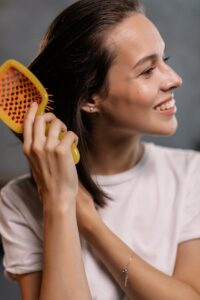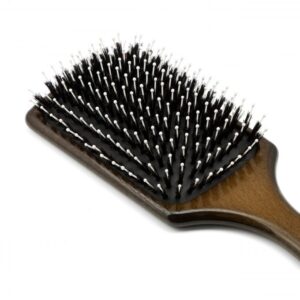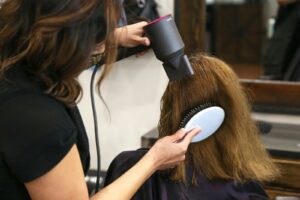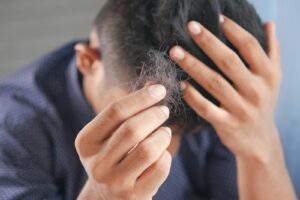The Science of Brushing: How 100 Strokes Boosts Hair Health & Scalp Care
Brushing your hair is often seen as a mundane task, yet it plays a crucial role in maintaining hair and scalp health. Understanding the science behind hair brushing can transform your hair care routine and significantly enhance the overall health of your hair. This article explores the importance of brushing, the benefits of regular brushing, and how the act of brushing affects hair health. By adopting a consistent brushing practice, you can ensure that your hair remains beautiful and vibrant.
Understanding the Importance of Hair Brushing

Photo by Alena Darmel on Pexels
Why Brush Your Hair?
Brushing your hair is essential for several reasons. It helps to distribute natural oils throughout your hair, keeping it hydrated and nourished. For those with long hair, brushing can prevent tangles and reduce breakage, particularly when using the right type of brush. A paddle brush or a boar bristle brush is often recommended as they are best for smoothing hair and minimizing damage. Regular brushing also stimulates the scalp, promoting hair growth by enhancing blood circulation to hair follicles, which is key for maintaining healthy hair.
The Benefits of Regular Brushing
Incorporating a brushing routine into your hair care regimen offers numerous benefits. For instance, brushing your hair 100 strokes daily can significantly reduce the chances of hair loss and hair breakage. This practice is particularly beneficial for thick or curly hair, which often requires more attention to prevent dryness and damage. Moreover, brushing helps to remove dirt and product buildup, ensuring that hair products work effectively. By keeping your hair healthy and well-maintained, you can enjoy beautiful, vibrant locks that reflect your commitment to proper hair care.
How Brushing Affects Hair Health
The way you brush your hair can greatly influence its health. Different hair types, whether fine, thick, or curly, require specific brush types to avoid damage. Using a detangling brush on wet hair can prevent breakage, while a round brush can aid in styling. Regular brushing not only helps to smooth the hair shaft but also reduces frizz and enhances shine. By making sure to brush your hair gently and consistently, you can maintain scalp and hair health, ensuring that each strand remains strong and resilient against potential damage.
Types of Hair Brushes and Their Uses

Paddle Brush: Ideal for Long Hair
The paddle brush is a versatile tool that excels in managing long hair. Its wide, flat surface allows for efficient brushing, making it ideal for smoothing out tangles and distributing oils throughout your hair. When you brush your hair with a paddle brush, you can cover larger sections, which helps to keep your hair healthy and hydrated. This brush is particularly beneficial for those with straight or slightly wavy hair, as it helps to prevent breakage while enhancing the overall shine of your locks.
Bristle Brush: Best for Thick and Curly Hair
Bristle brushes are specifically designed for thick and curly hair types. Their densely packed bristles work effectively to penetrate the hair shaft, allowing for better distribution of natural oils throughout your hair. When you brush curly hair with a bristle brush, you can detangle knots without causing excessive breakage. This brush helps maintain the moisture balance, keeping your curls defined and bouncy. Additionally, using a bristle brush on thick hair can enhance overall scalp health by stimulating blood flow to the hair follicles, promoting hair growth.
Round Brush: Perfect for Styling and Volume
Round brushes are essential for achieving volume and styling your hair. They are particularly useful during blow-drying, as they help create curls and waves while adding lift to the roots. When you use a round brush, you can wrap sections of wet hair around the brush to smooth the hair shaft and eliminate frizz. This technique not only enhances the appearance of your hair but also contributes to a healthier overall look. Whether you have fine or thick hair, a round brush can be the best tool for creating beautiful, salon-worthy styles at home.
Boar Bristle Brush: Nourishing Your Hair
The boar bristle brush is renowned for its ability to nourish and enhance the health of your hair. It effectively distributes natural oils from the scalp throughout your hair strands, which is essential for keeping your hair hydrated and shiny. This brush type is particularly effective for those with thick or dry hair, as it minimizes breakage and promotes healthy hair growth. By regularly using a boar bristle brush, you can maintain the health of your scalp and hair, ensuring that each stroke contributes positively to your overall hair care routine.
Detangling Brush: Preventing Breakage
Detangling brushes are designed to gently remove knots and tangles without causing breakage. They are ideal for use on wet hair, making them a staple in many hair care routines. When you brush your hair with a detangling brush, you can effectively loosen knots without the harshness of traditional brushes. This is especially important for individuals with curly or thick hair, where breakage can be a common issue. By incorporating a detangling brush into your hair care regimen, you can keep your hair healthy and minimize damage, allowing for a smooth and manageable finish.
Choosing the Right Brush Type for Your Hair

Photo by Michelle Leman on Pexels
Identifying Your Hair Type: Thick, Thin, or Curly
Understanding your hair type is crucial when it comes to selecting the right brush. Thick hair typically requires a robust brush that can handle the density and manage tangles effectively, while fine hair benefits from a gentler touch with a brush that minimizes breakage. For curly hair, a wide-tooth comb or a bristle brush is often the best choice, as it can navigate the curls without disrupting their natural pattern. Identifying whether your hair is long, short, straight, or wavy also plays a significant role in choosing the most effective brush type for your needs. By recognizing your unique hair characteristics, you can select a brush that not only enhances your hair health but also simplifies your hair care routine.
Best Hair Brushes for Fine Hair
When it comes to fine hair, using the right brush is essential to avoid breakage and promote hair health. A paddle brush with soft bristles is often recommended, as it glides through hair without pulling or tugging. Additionally, a round brush can be beneficial for styling, adding volume while remaining gentle on the hair shaft. It’s important to choose brushes that are lightweight and designed specifically for fine hair, as these will help distribute oils throughout your hair and keep your hair hydrated. Incorporating these brushes into your hair care routine can significantly reduce the chances of hair loss and maintain the overall health of your strands.
Selecting the Right Brush for Straight Hair
For those with straight hair, choosing the right brush can enhance both hair health and styling ease. A wide paddle brush is often the best option, as it allows for quick detangling and smoothing of the hair shaft. This brush type also helps distribute natural oils throughout your hair, promoting hydration and shine. Additionally, using a round brush during styling can create volume and a polished look. It’s essential to brush straight hair regularly, as this practice not only prevents breakage but also stimulates the scalp, promoting hair growth. By selecting the appropriate brush, you can keep your hair healthy and looking beautiful.
Brushing Techniques for Healthy Hair

Photo by Giorgio Trovato on Unsplash
How to Properly Brush Your Hair
To properly brush your hair, start by selecting the right brush type that suits your hair type. For long hair, a paddle brush can effectively manage tangles while distributing natural oils throughout your hair. Begin brushing gently from the tips, gradually working your way up to the roots to prevent breakage. It’s important to hold sections of your hair to minimize tension on the scalp and hair strands. Regular brushing not only keeps your hair healthy but also promotes scalp health, enhancing blood circulation to hair follicles and supporting hair growth.
The 100 Strokes Method: A Traditional Approach
The 100 strokes method is a time-honored technique aimed at boosting hair health. This method involves brushing your hair 100 times daily, which can help distribute oils throughout your hair and stimulate the scalp. As you brush, ensure you are using a soft-bristled brush, such as a boar bristle brush, to prevent hair damage and minimize breakage. This approach is particularly beneficial for thick or dry hair, as it encourages moisture retention and keeps your hair hydrated. By incorporating this method into your hair care routine, you can achieve beautiful, glossy locks while maintaining overall hair health.
Tips to Minimize Hair Loss and Breakage
To minimize hair loss and breakage, it’s essential to adopt gentle brushing techniques. Always choose a brush appropriate for your hair type; for example, a detangling brush is best for wet hair, whereas a bristle brush works well on dry hair. Avoid brushing aggressively, as this can lead to significant hair breakage. Additionally, consider brushing your hair regularly to enhance the health of your scalp and stimulate hair follicles, promoting hair growth. Incorporating these practices into your daily routine can help keep your hair healthy and reduce the risk of hair loss.
Common Mistakes to Avoid When Brushing

Photo by Towfiqu barbhuiya on Unsplash
Using the Wrong Brush Type
Using the wrong brush type can lead to damage and hinder your hair care efforts. For instance, using a stiff brush on fine hair can cause breakage, while a gentle brush is best for thin hair. Thick or curly hair requires a bristle brush or a wide-tooth comb to avoid tangling and to distribute oils throughout your hair. Always evaluate your hair type before selecting a brush; the right hair brush can significantly enhance your hair care routine and ensure that your hair remains beautiful and healthy.
Brushing Wet Hair: Risks and Recommendations
Brushing wet hair poses risks, as hair is more vulnerable to breakage in this state. Using a detangling brush specifically designed for wet hair is recommended, as it can gently remove knots without causing damage. Avoid using a regular brush on wet hair, as this can lead to significant hair loss and breakage. Instead, allow your hair to dry partially before using a brush, or consider transitioning to a wide-tooth comb. By being mindful of how you brush wet hair, you can protect your hair’s integrity and maintain its health.
Brushing Too Aggressively
Brushing too aggressively can result in hair damage and loss. It’s crucial to adopt gentle brushing techniques, particularly for delicate hair types. Aim to use smooth, even strokes, and avoid yanking or tugging at knots. This approach not only minimizes breakage but also promotes scalp and hair health by ensuring that blood circulates effectively to the hair follicles. When brushing, take your time and be attentive to your hair’s needs, as this will ultimately help make your hair healthier and more resilient against damage.
Frequently Asked Questions About Hair Care
What is the best way to brush your hair?
Brushing your hair is essential for maintaining hair health, but the technique matters! Start at the ends and gently work your way up to avoid breakage. Use a detangling brush for wet hair, and switch to a paddle brush or boar bristle brush for dry hair. Remember, the right brush type can make a world of difference in keeping your hair shiny and healthy!
How often should I brush my hair?
It’s recommended to brush your hair at least twice a day. This helps to distribute natural oils throughout your hair, keeping it hydrated and healthy. However, the frequency can depend on your hair type. For those with curly hair, it might be best to brush your hair less frequently to avoid frizz and maintain your natural curls!
What are the benefits of using a boar bristle brush?
A boar bristle brush is excellent for promoting hair growth and maintaining scalp health. It helps in distributing oils from the scalp down the hair shaft, ensuring that your hair stays moisturized and shiny. This brush type is particularly beneficial for those with long or thick hair, as it can glide through your locks without causing hair breakage.
Can hair products affect how I brush my hair?
Absolutely! The type of hair products you use can significantly influence hair styling and brushing. Products that leave residue can cause tangles, making it harder to brush your hair effectively. Always choose lightweight products that promote healthy hair and consider using a detangling brush for easier brushing after applying products.
How can I reduce hair breakage while brushing my hair?
Reducing hair breakage while brushing is essential for maintaining healthy, beautiful hair. Here are some tips to help you minimize damage:
1. Choose the Right Brush: Use a wide-tooth comb or a brush specifically designed for detangling. Look for brushes with soft bristles that glide through the hair without tugging.
2. Brush When Dry: It’s best to brush your hair when it is dry, as wet hair is more prone to breakage. If you need to detangle wet hair, use a wide-tooth comb and be gentle.
3. Start from the Tips: Begin brushing at the ends of your hair and work your way up to the roots. This method helps to gently remove tangles without putting too much stress on the hair shaft.
4. Use a Leave-In Conditioner: Applying a leave-in conditioner or detangling spray can help soften your hair and make it easier to brush through, reducing the risk of breakage.
5. Limit Heat Styling: Excessive heat can weaken hair, making it more susceptible to breakage. Try to limit the use of heat styling tools, or use them on a lower setting with a heat protectant product.
6. Be Gentle: Avoid pulling or yanking at knots. If you encounter a tangle, take your time to work it out slowly.
7. Maintain Regular Haircuts: Regular trims can help remove split ends and prevent breakage from traveling up the hair shaft.
8. Stay Hydrated: Drink plenty of water and maintain a balanced diet rich in vitamins and minerals to support overall hair health.
9. Avoid Tight Hairstyles: Tight ponytails or braids can cause stress on the hair and lead to breakage. Opt for looser styles and use soft hair ties.
10. Limit Chemical Treatments: Frequent coloring, perming, or relaxing can weaken hair. If you must chemically treat your hair, make sure to follow up with deep conditioning treatments.
By following these tips, you can significantly reduce hair breakage while brushing and promote healthier hair overall.

